February 2024
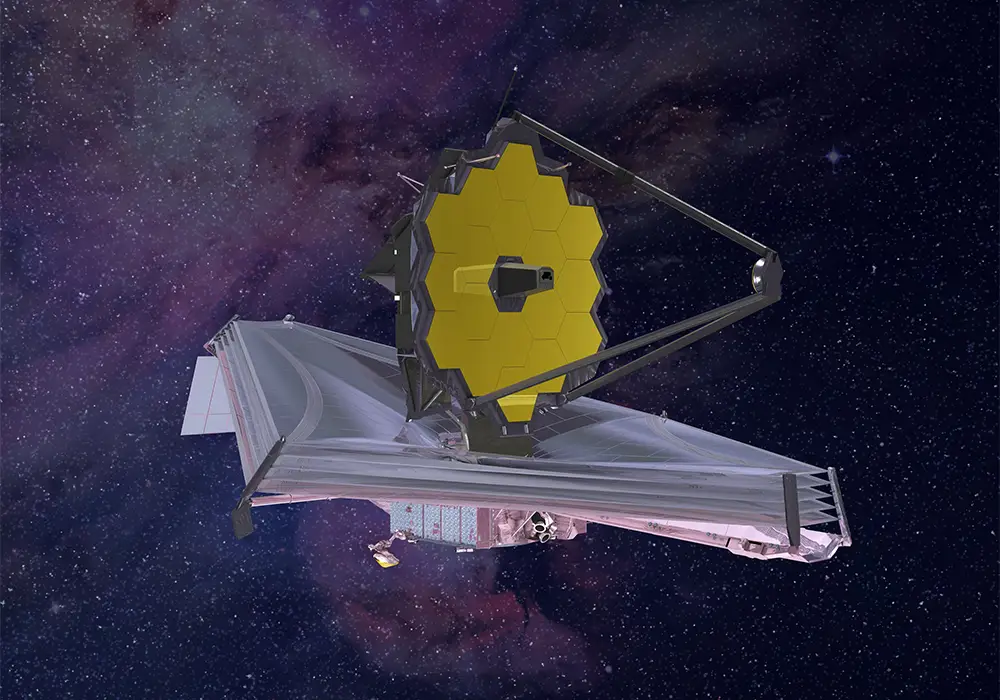
Artist depiction of the James Webb Space Telescope. (NASA / Northrop Grumman)
Humankind's greatest space science facility
The James Webb Space Telescope (JWST) is NASA’s flagship astronomy and astrophysics mission that was launched on December 25, 2021 and placed into a halo orbit at Lagrange Point 2 (L2), 1.5 million km from Earth (see figure and animation below). The launch on an Ariane 5 rocket, provided by the European Space Agency, was extremely precise. The end of life for many space missions is due to depletion of thruster fuel. The accuracy of launch saved so much of JWST’s hydrazine thruster fuel that JWST has enough fuel to operate for more than 25 years, much longer than the minimum 5-year design lifetime.
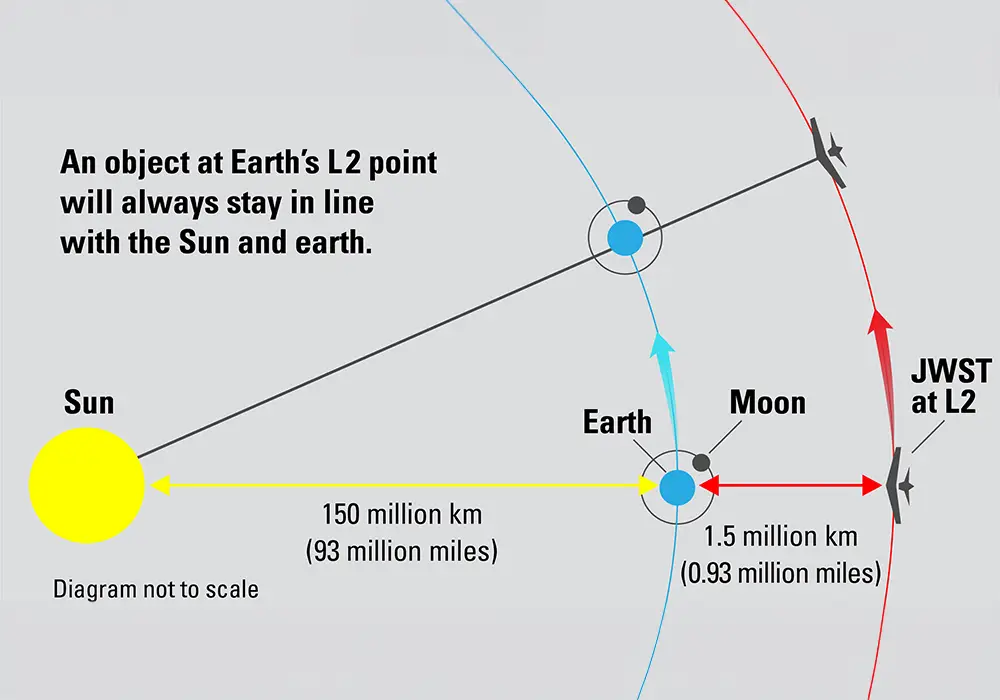
Teledyne
The James Webb Space Telescope is in a halo orbit about L2, 1.5 million km from Earth.
JWST will be the premier space astronomy observatory for the next two decades, serving thousands of astronomers worldwide. JWST is an infrared optimized observatory with several advantages over the Hubble Space Telescope:
- Placed in orbit at L2, JWST’s tennis court sized five-layer sunshield attenuates heat from the Sun, Earth, and Moon by more than a million times. This environment enables the 6.5-meter primary mirror to radiatively cool to 50 degrees Kelvin (-370 degrees Fahrenheit) so that the primary mirror will not emit any infrared radiation in the 0.6 to 5 μm range of the three instruments that use Teledyne’s infrared detectors. Hubble is a visible light optimized telescope that keeps its primary mirror at a temperature of 294 Kelvin (70°F).
- JWST’s 6.5-meter diameter mirror has 7 times the light collecting area of HST.
- JWST has 66 million infrared (IR) pixels in the focal planes of its 4 instruments compared with the 1 million IR pixels in HST. Teledyne supplied 63 million IR pixels for 3 of JWST’s instruments: Near Infrared Camera (NIRCam), Near Infrared Spectrograph (NIRSpec), and the Fine Guidance Sensor (FGS).
JWST uses 15 of Teledyne’s H2RG 2048×2048 pixel infrared detectors. To completely eliminate dark current, the detectors are operated at 37 degrees Kelvin (-393°F). Teledyne also supplied the SIDECAR ASIC focal plane electronics that operate the H2RG arrays. The detectors and electronics must operate at very low power due to the difficulty of removing heat at the very low temperature of operation. Each H2RG array consumes less than 0.5 mW and each SIDECAR ASIC module consumes less than 15 mW.
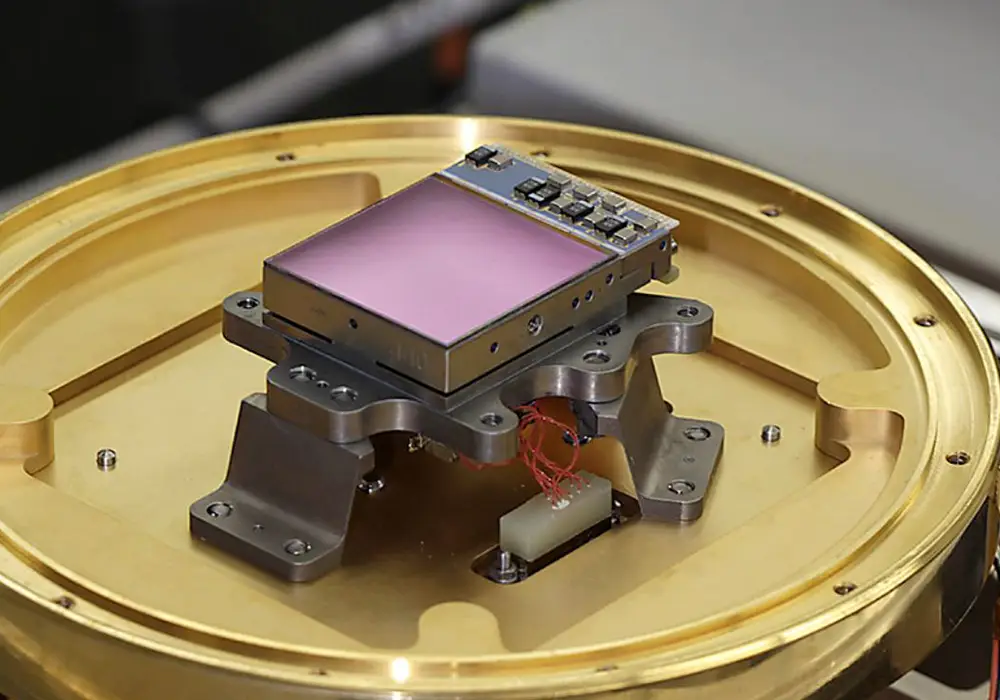
H2RG 4 million pixel infrared detector (Teledyne)
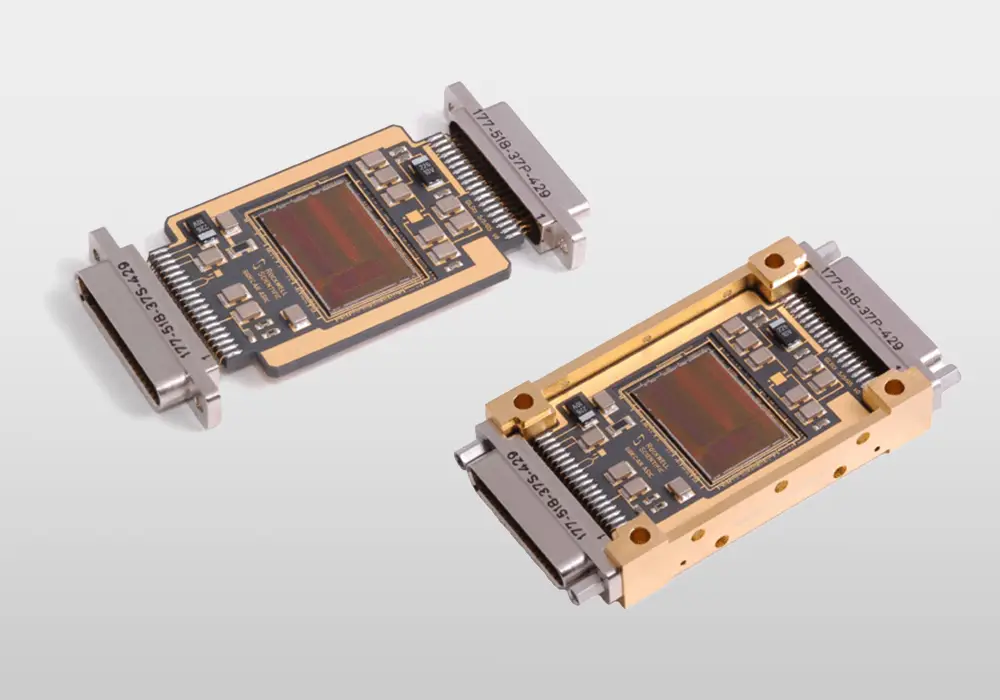
SIDECAR ASIC modules (Teledyne)
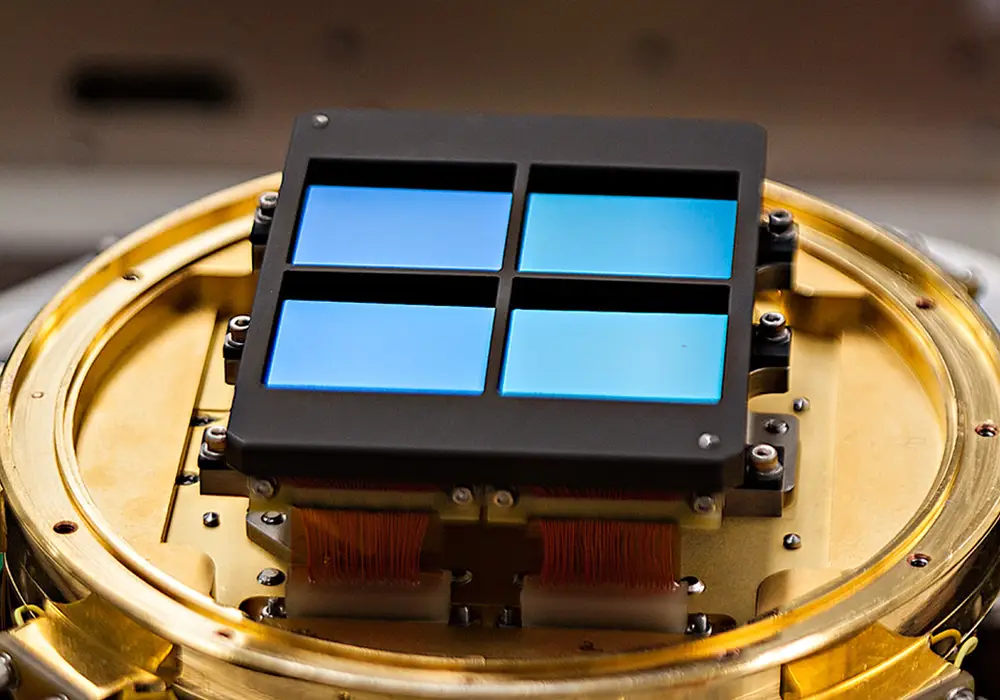
Mosaic of four SWIR H2RG arrays for the NIRCam instrument of JWST. (NASA/U. Arizona)
The James Webb Space Telescope is a giant leap forward in our quest to understand the Universe and our origins. JWST will examine every phase of cosmic history from the first luminous glows after the Big Bang to the formation of galaxies, stars, and planets to the evolution of our own solar system.
The major science areas of JWST are:
-
First light and reionization: JWST is a powerful time machine with infrared vision that will look back 13.5 billion years to see the first stars and galaxies forming in the early Universe.
-
Assembly of galaxies: JWST’s unprecedented infrared sensitivity will help astronomers compare the faintest, earliest galaxies to today’s spiral and elliptical galaxies, helping us understand how galaxies assemble over billions of years.
-
Birth of stars and protoplanetary systems: JWST will be able to see through and into massive clouds of dust that are opaque to visible-light observatories (like Hubble), where stars and planetary systems are being born.
-
Planets and origins of life: JWST will tell us more about the atmospheres of extrasolar planets, and perhaps even find the building blocks of life elsewhere in the Universe. In addition to other planetary systems, JWST will also study objects within our own solar system.
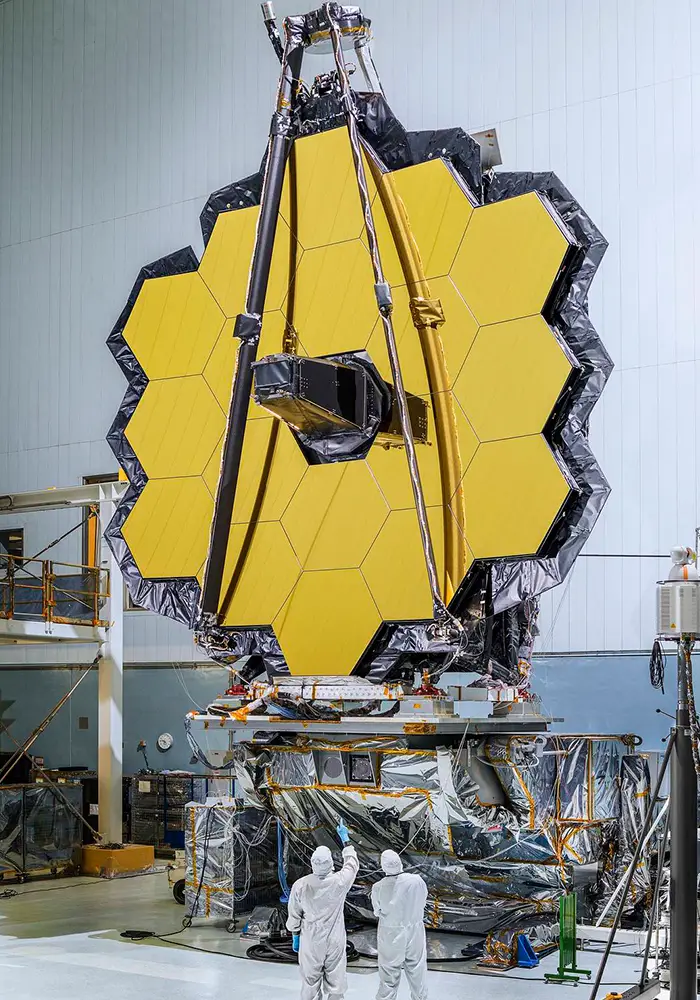
Engineers at Goddard Space Flight Center inspect the 6.5-meter diameter JWST primary mirror after installation of the 18 hexagonal mirror segments. (NASA / Chris Gunn)
Examples of scientific images
NASA has several websites where the processed science images and explanations of science can be found. A few are:
JWST has already produced so much science that a full week meeting could be held with each scientific observation limited to a 10 minute presentation. The examples presented in this article are a small selection of JWST observations that demonstrate the range of JWST science:
- Deep view of the distant universe
- Star forming region in our Milky Way
- Rare class of star, a Wolf-Rayet star
- Completely new view of the planet Uranus
Deep view of the distant universe
One of the first images released from JWST was an image of the galaxy cluster SMACS 0723 (see below). There are thousands of galaxies in this small patch of sky that is approximately the size of a grain of sand held at arm’s length. This is one ten-millionth of the full sky. The JWST image alternates with the same area of sky imaged by HST. The JWST image is the sum of 12.5 hours of exposures whereas HST needed to integrate for nearly two weeks.
At the center of the image is a galactic cluster (seen in white in the JWST image) that is 4.6 billion light-years from Earth. There is a large amount of gravity concentrated in the cluster, gravity from both normal matter and dark matter. This creates a “gravitational lens” that distorts the images of more distant galaxies that are ~13 billion light-years from Earth (shown as red). Some of the warped galaxy images are actually multiple images of the same distant galaxy. Astronomers correlate the multiple lensed images of distant galaxies by measuring their spectra. Spectra serve as fingerprints since each galaxy has a unique chemical composition.
The Carina Nebula star forming region - the "Cosmic Cliffs"
The Carina Nebula in our Milky Way galaxy, 7,600 light-years from Earth, hosts a star forming region named NGC 3324. This NGC 3324 image, also known as the “Cosmic Cliffs”, is one of the youngest star forming regions known; it is only 500,000 years old. It is also very hot, about 37,200 Kelvin.
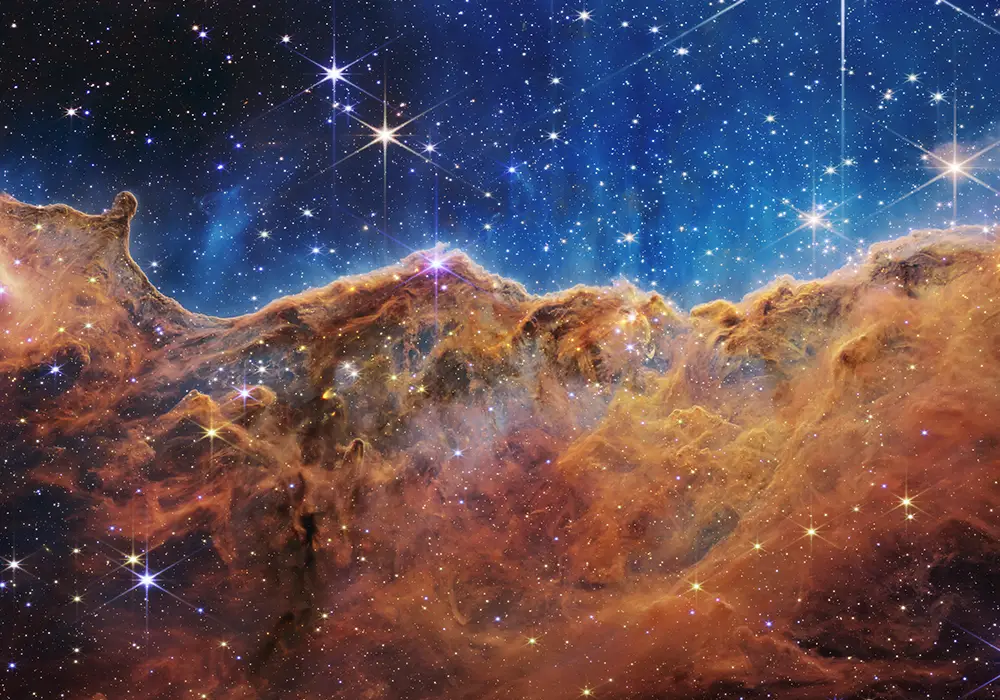
NASA
As with many of the publicly released images from JWST, this image results from the composition of a large number of JWST images. This NGC 3324 image is a combination of 600 images taken by NIRCam’s eight short-wave infrared (SWIR) and two mid-wave infrared (MWIR) H2RG detectors. The composite image is created by dithering and mosaicking images taken through filters centered at 0.90, 1.87, 2.00, 3.35, 4.44, and 4.70 µm wavelengths.
- The 1.87 µm filter isolated the Passchen alpha emission line of hydrogen. This narrow band in the infrared is color-coded for human visible eyes as the “blue sky” shown in the image.
- The 3.35 µm filter detects the non-thermal emission of polycyclic aromatic hydrocarbons. These molecules are excited by ultraviolet photons but decay at low density. The light detected by the 3.35 µm filter is shown by the orange color and gives the clouds a mountainous 3-D look.
The image shown above is about 15 light-years wide and 8 light-years tall. For reference, the closest star to our Sun is about 4.2 light-years from Earth.
A most peculiar star - Wolf-Rayet 14
The image below left looks unreal, appearing like an optical distortion or tree rings. But this is a real image of a rare class of star called “Wolf-Rayet” (or WR), named after the French astronomers Charles Wolf and Georges Rayet who discovered the first WR stars in 1867 at the Paris Observatory. Located 5,000 light-years from Earth, this Wolf-Rayet star is a massive O-type star that is blowing out gas at a prodigious rate and high speed, at 3,800 km per second. That is almost 9 times faster than our Sun expels its solar wind.
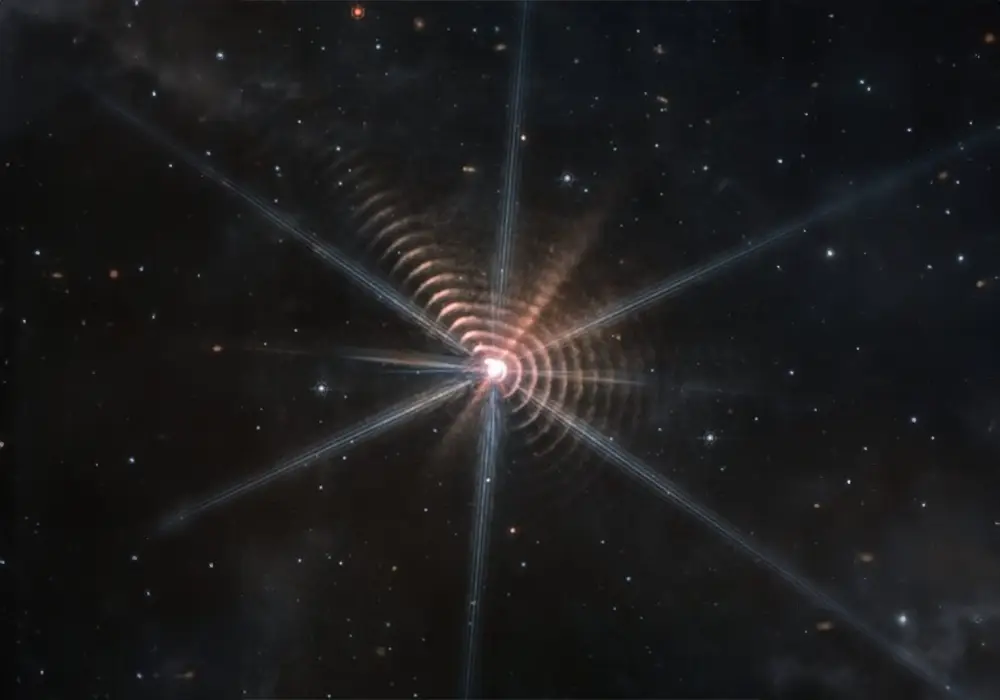
NASA
This Wolf-Rayet star, named WR14, is part of binary pair that orbit each other every 8 years. As shown by the animation at right, when the companion star gets close to WR14, the gas emission is increased which produces the ring structure seen in the image at left. If you count carefully, you can see about 20 rings, which is a snapshot of about 160 years in the life of WR14 - from 5,000 years ago since it is 5,000 light-years from Earth.
A new view of Uranus
Uranus is the seventh planet from the Sun and it is the oddball in our solar system family. Uranus rotates on its side which causes extreme seasons since each pole of Uranus experiences long periods of illumination and darkness as Uranus orbits the sun every 84 years. Theories proposed to explain the odd tilt include a massive Uranus moon that destabilized and crashed into Uranus, giant impacts during the formation of Uranus, and the solar system gas giants exerting resonant torques on each other.
The Hubble Space Telescope imaged Uranus in November 2022 producing the visible light image shown below at left. The HST image is a composite of three filters at 0.467, 0.547, and 0.845 µm. When displayed for our eyes that can sense 0.4 to 0.7 µm light, the composite HST image respectively colors the three wavelengths as blue, green, and red.
When viewed by JWST’s infrared eyes, a much different view of Uranus is revealed (see image below right). The JWST image shows dramatic ring structure and bright features in Uranus’ atmosphere. The infrared image which shows Uranus’ north pole is a combination of four of NIRCam’s filters: 1.4 µm (shown as blue), 2.10 µm (cyan), 3.0 µm (yellow) and 4.6 µm (orange). The bright spots seen outside Uranus’ rings are some of Uranus 27 known moons, and some small moons can be seen within the rings.
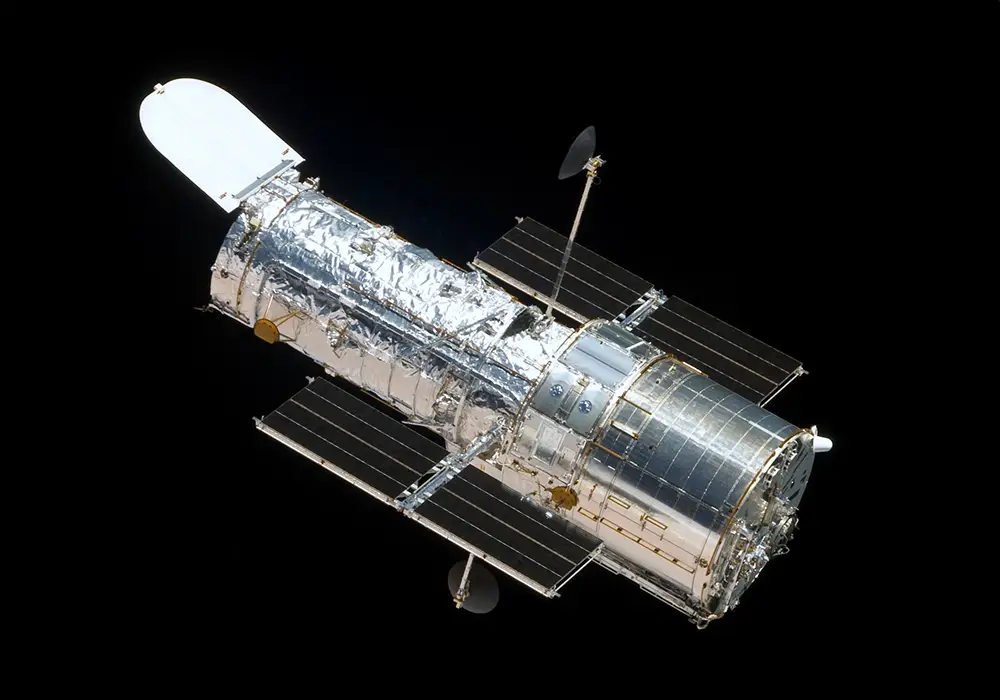
HST - Image credit of NASA
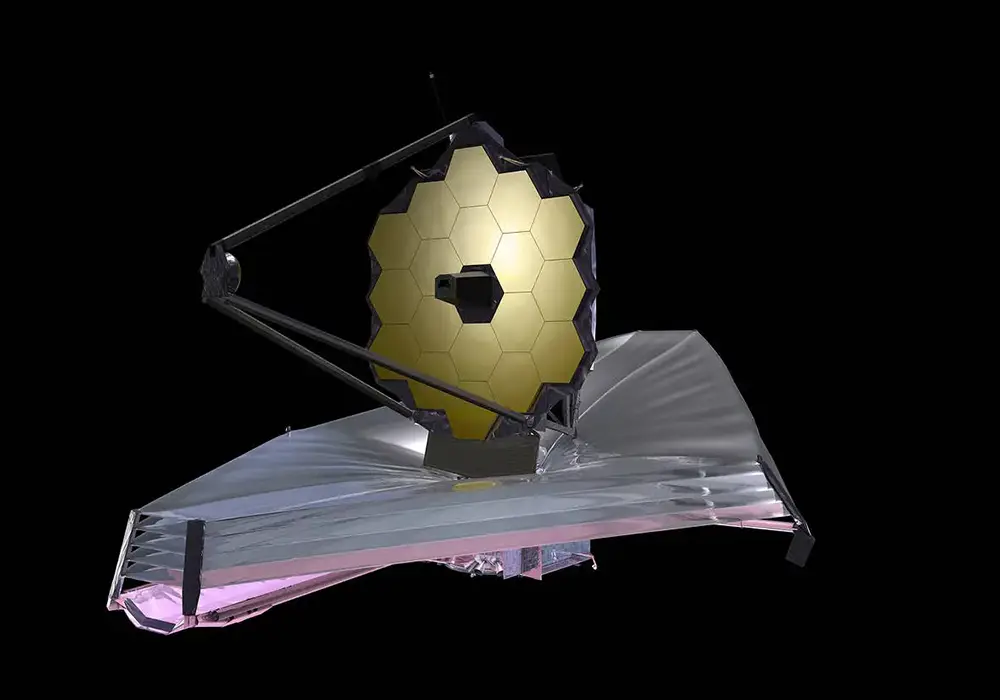
JWST - Image credit of NASA
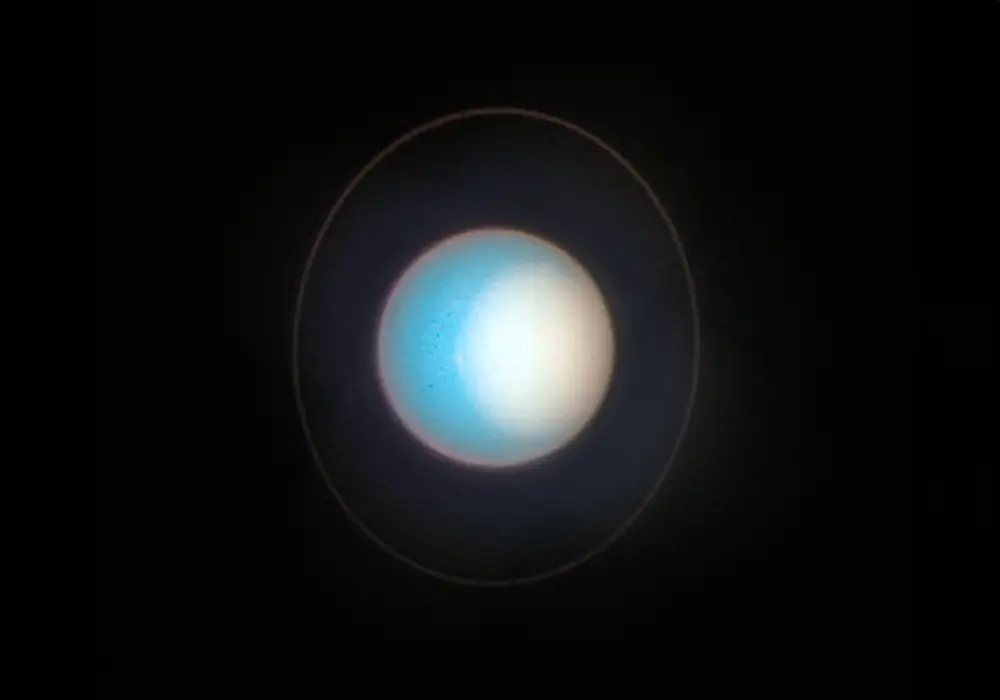
HST (Nov 2022) - Image credit of NASA
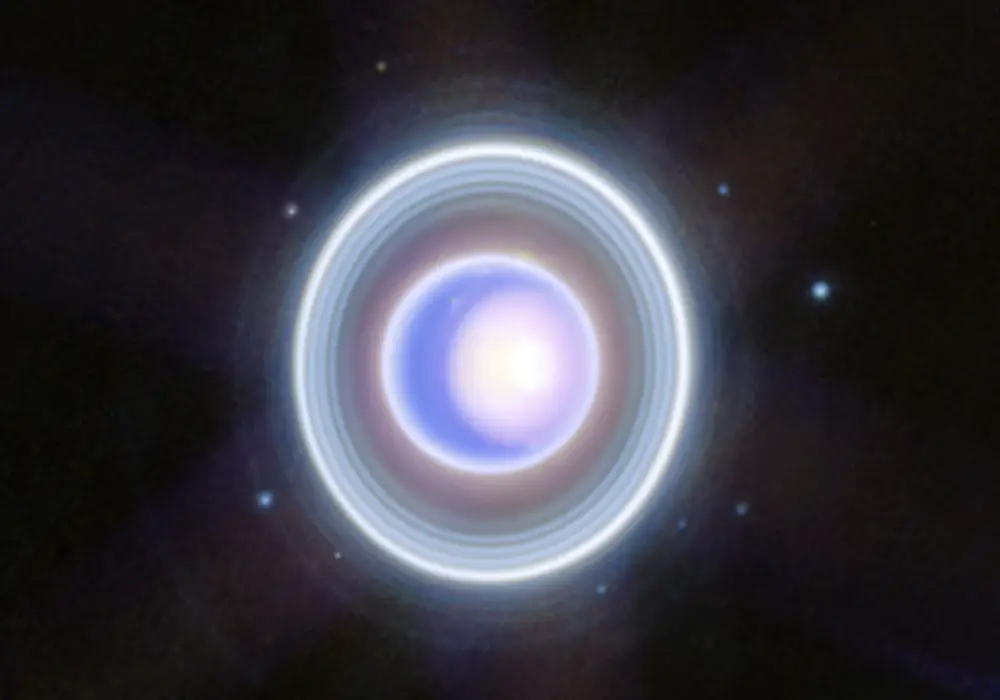
JWST (Sept 2023) - Image credit of NASA
